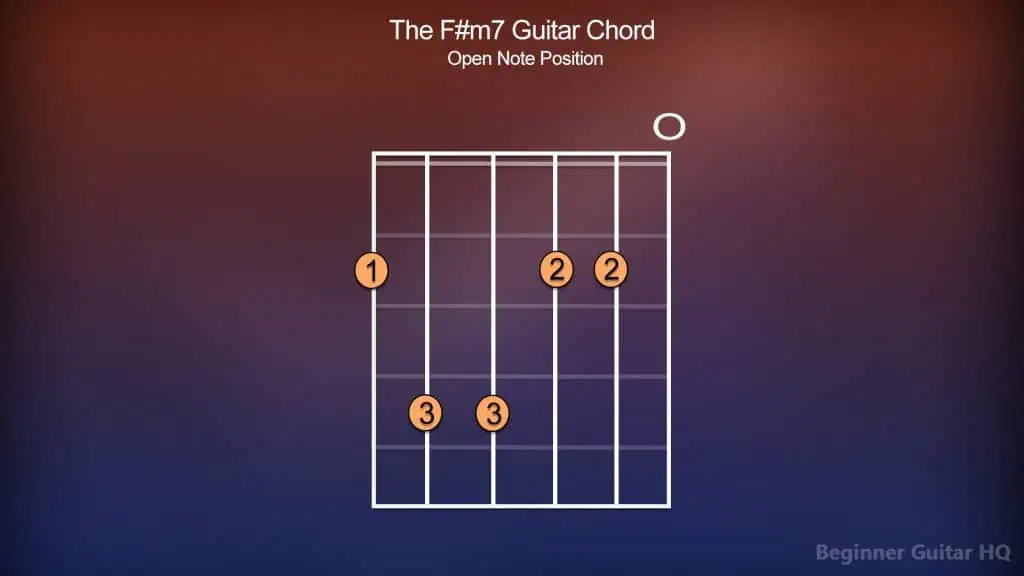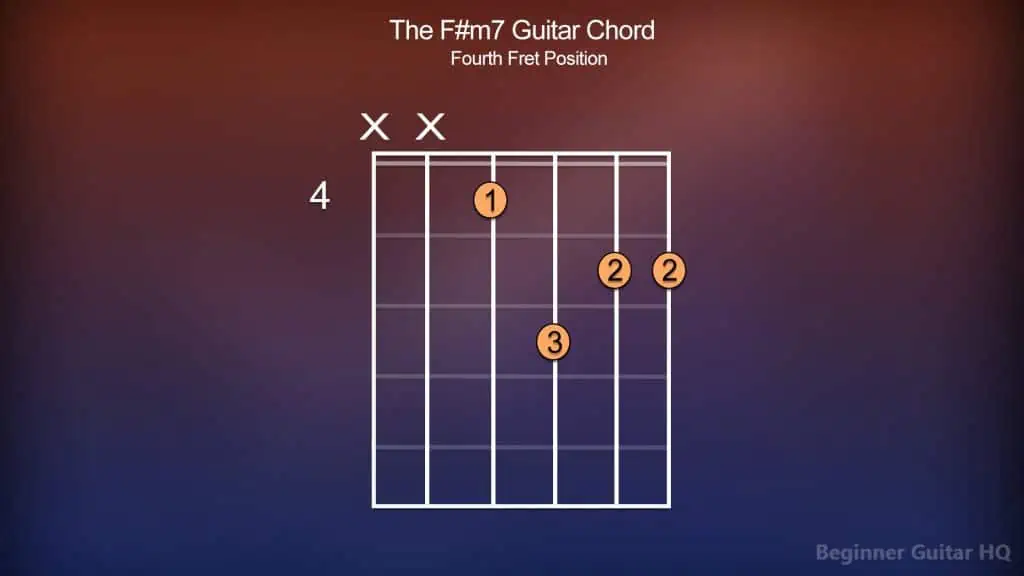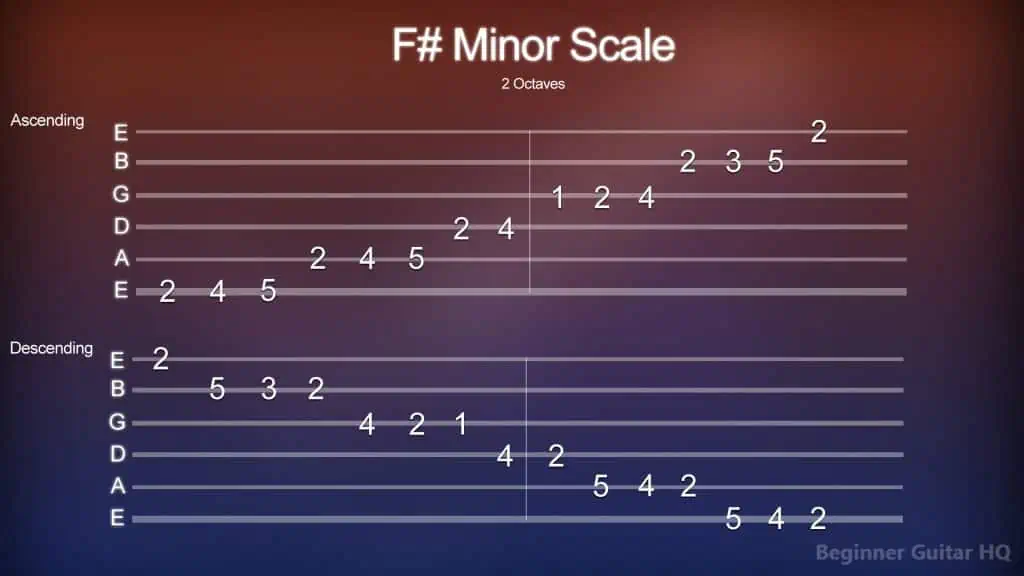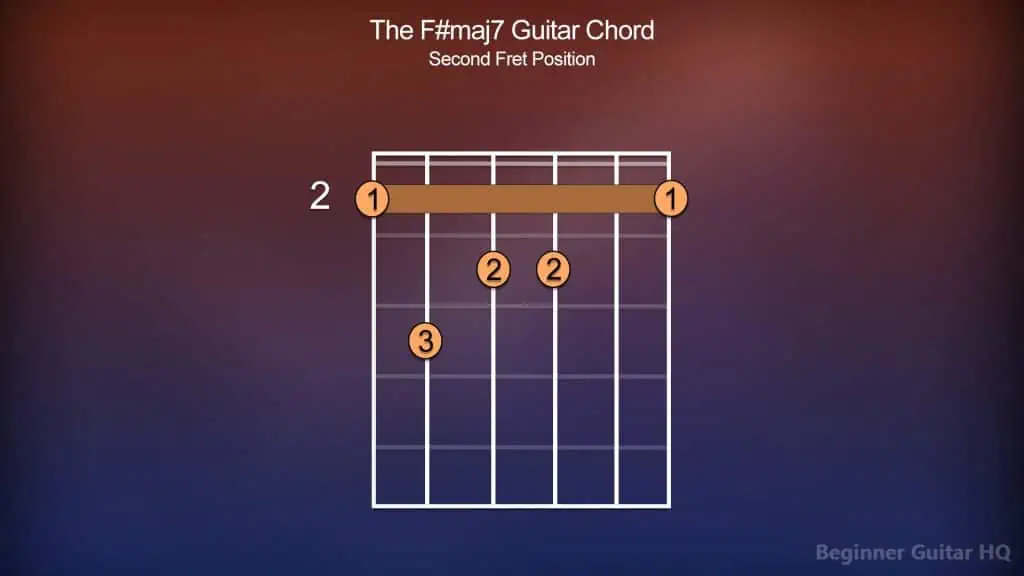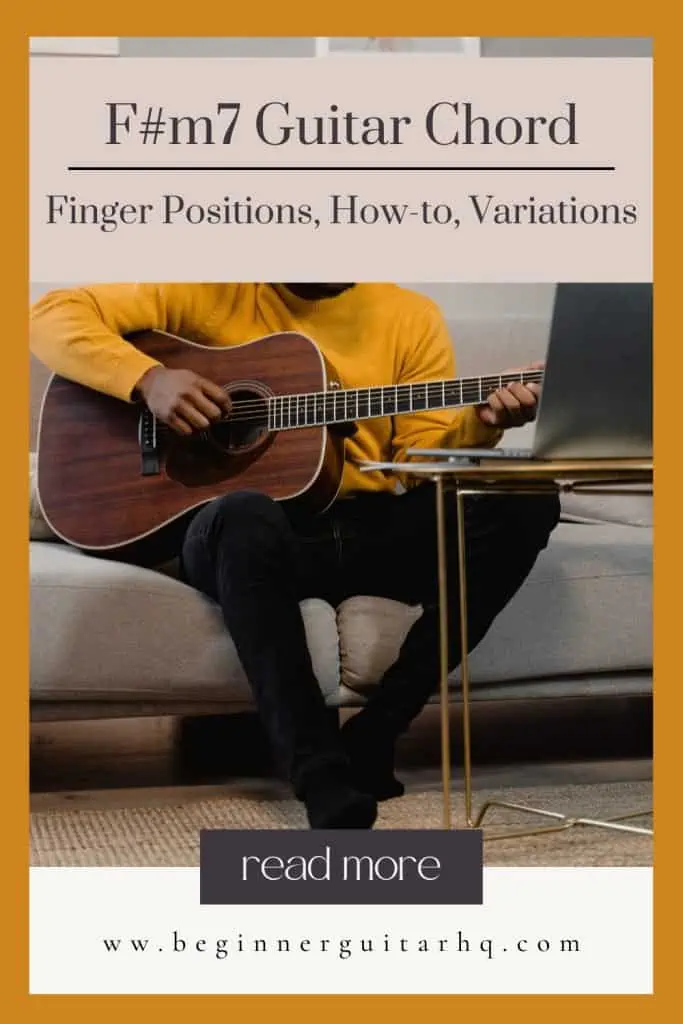Are you looking for some smooth and sophisticated-sounding chords to add to your chord repertoire? Then you’ve come to the right place! The F#m7 is a wonderfully jazzy guitar chord, offering a little bit of challenge for beginners, but nonetheless a great sound. As you read on, we’ll cover how you can play this chord, as well as how it works, allowing you to take this knowledge to other chords you wish to learn in the future. Let’s dive in!
Contents
How to Play the F#m7 Chord
One of the really cool things about the guitar is the number of ways you can play the same chord. We call these variations. Variations, not to be confused with inversions, don’t merely flip the chord on its head, changing the bottom note of the chord; variations can sometimes include two or more of the same note being played enharmonically from different positions on the fretboard!
So, what’s the point of playing variations if they’re really just the same chord? There are actually a number of beneficial reasons to chord variations:
The flow of your chord progression. Sometimes it just makes sense to play one variation over another depending on the other chords in your chord progression. For instance, if your chord progression hovers around the 2nd fret, then why play something around the 7th fret? It might not always make sense, however, this decision is up to the guitarist!
Your skill level as a guitarist. If you’re a beginner, there may be some chords that you’ll encounter that might be a little too challenging! That’s okay. You’ll typically want to stick to what feels most comfortable, and something you know you can play, especially within a chord progression. Especially to maintain confidence as a musician! However, it might be good to challenge yourself from time to time to test your skill level, in which case, you might even opt for a more challenging variation!
The overall sound qualities. While, yes, variations of chords are technically the same chord, there are some slight audible differences. This can come from which notes are played enharmonically within the chord, bringing out different colors and tonal qualities. In some cases, you might actually prefer the way one variation of a chord sounds over another, based on this feature!
Your personal preference. When it comes down to choosing one chord to another, we have our own personal biases; our favorites. This can be based on any of the aforementioned factors in deciding which variation to use, or perhaps, another reason of your own! The important thing is to understand there are no right or wrong answers and to choose what you enjoy.
Now, without further ado, let’s try playing the F#m7 chord, and a couple of its variations:
Chord diagram of the F#m7 chord from the open note position.
Chord diagram of the F#m7 chord from the fourth fret position.
Chord diagram of the F#m7 chord from the ninth fret position.
Trouble With Chord Charts?
If this is your first time seeing a chord chart, don’t panic, they’re relatively easy to learn and will serve you for years to come! Let’s first bring our attention to the big rectangular box, containing a number of vertical and horizontal lines; this represents our fretboard. Each vertical line represents a different string on the guitar. From the left to the right, we have our low E, A, D, G, B, and high E strings. Each horizontal line, however, separates one fret from the next.
Within the frets, and on the strings, you’ll notice a circle containing a number anywhere from 1 – 4. These numbers represent each of our fingers, and where they’re supposed to be placed on the fretboard to form our chord. The number 1 represents our index finger. The number 2 represents our middle finger. The number 3 represents our ring finger. Finally, the number 4 represents our pinky finger. If, however, there is a long dark bar stretching across a number of strings, this indicates that you’re supposed to form a “barre”. A barre is a necessary component of forming a “barre chord”, and is achieved by draping your index finger across a grouping of strings and applying pressure.
Next, let’s bring our attention to the top of the fretboard, primarily, above the strings. On some chords, you might notice an “O” or an “X”. If there is an “O” present, then this means that you’re to play an open note on the corresponding string (a string to be played but not fretted). If, however, there is an “X” present, then you’re not to play that string to complete the chord. Finally, bringing our attention to the left side of the fretboard, you may sometimes see a number. If a number is present, then that means that you’re to form the chord starting from that fret. If there are no numbers present, then it’s generally implied that you’re starting from the open note position.
That’s all there is to it!
Breakdown of the F#m7 Chord
The F#m7 chord, otherwise known as the F sharp minor seventh chord, is used a lot in the world of Jazz, and Blues music. In fact, it’s an excellent chord for adding an extra layer of tension to a chord progression, by slapping that minor 7th on top of the already existing minor triad. While it is widely known for being used across Jazz music, seventh chords like this aren’t uncommon in other genres looking for the same jazzy aesthetic.
So, how does a chord like the F#m7 work?
To better understand the F#m7 chord, we’ll need to review a few fundamental components that build its foundation: the key, scale, and triad.
Let’s begin with the key. The key can be described as a grouping of musical pitches no different than what you’d find in a scale. How do we define these pitches? That’s where the key signature comes into play. Every key has its own key signature. The key signature is often visually represented by the grouping of sharps (#) and flats (b) you’ll find after the clef on a piece of sheet music. A note that is marked as sharp is to be raised by a semitone. However, a note that is marked as flat is to be lowered by a semitone.
How do we find out which notes are sharp or flat in a given key? That’s where it can help to consult the circle of fifths.
Diagram of the circle of fifths, displaying the most commonly used keys.
The circle of fifths is a wheel-shaped diagram displaying the most commonly used keys and their corresponding key signatures. Within the wheel, there are two rings. The inner ring houses all of our minor keys, while the outer ring houses all of our relative major keys (keys that have a different root note but share the same key signature). Starting from A minor, going clockwise around the wheel, you’ll see that every key gains an additional sharp to its key signature. Starting from A minor, once again, and going counterclockwise, you’ll see that every key gains an additional flat to its key signature. Since, however, our chord is F#m7, we’ll be focusing on the right half of the wheel, containing the sharps.
So, how do we determine which notes are sharp in a given key? We use a simple acronym, FCGDAEB. This stands for:
“Father, Charles, Goes, Down, And, Ends, Battle”
The first letter of each word within this acronym represents a different note to be made sharp, in sequence. Here is how that sequence appears on the circle of fifths:
a = No sharps or flats.
e = F#
b = F#, C#
f# = F#, C#, G#
c# = F# , C#, G#, D#
g# = F#, C#, G#, D#, A#
d# = F#, C#, G#, D#, A#, E#
a# = F#, C#, G#, D#, A#, E#, B#
For instance, if we know that B minor has two sharps in its key signature, then following the acronym and using our fingers, we’d go, “Father, Charles…” and therefore, the sharps within the key of B minor are F#, and C#. Let’s try it again, but with G# minor, containing five sharps. Using the acronym with our fingers, once again, “Father, Charles, Goes, Down, And…” therefore, the sharps within the key of G# minor are F#, C#, G#, D#, and A#.
Using this method with our current key, F# minor containing three sharps, what are they? That’s right! They are F#, C#, and G#. Now, let’s lay out the F# minor scale:
F# > G# > A > B > C# > D > E > F#
Minor scales contain a very strict pattern of tones (T) and semitones (S) that they always follow. Here is how that sequence appears:
T > S > T > T > S > T > T
As you can see, the first interval, F# > G# is a tone apart. However, due to our key signature and G becoming G#, this pushes it a semitone closer to A, making them a semitone apart in the second interval. For the third and fourth intervals, A > B, and B > C#, they are both tones apart. C becomes C# shifting closer to D, making them a semitone apart in the fifth interval. Finally, the sixth and seventh intervals, D > E, and E > F# are both tones apart. It never fails!
Now, let’s try playing our F# minor scale using tablature:
Guitar tablature of the F# minor scale, ascending and descending.
Trouble With Tablature?
Guitar tablature, otherwise known as “tab”, is an excellent means for guitarists with no musical background to write, share, and play some of their favorite songs and exercises. You might even think of tablature as a more simplistic alternative to sheet music, requiring no musical notation.
First, let’s bring our attention to the six horizontal lines; each of these lines represent a different string on the guitar. From the bottom to the top, we have our low E, A, D, G, B, and high E strings. On the lines, you’ll notice some numbers; these indicate which fret you’re supposed to play on the corresponding string. For instance, if we have the number 4 on the A string, then you’re to play the fourth fret of the A string. If you have the number 6 on the G string, then you’re to play the sixth fret of the G string. If, however, you see the number 0 on any string, then that suggests that you’re to play an open note on the corresponding string (a string to be played but not fretted).
It’s as easy as that!
Scale Degrees
Now that we’ve gone over our F# minor scale, it’s important to note that each note within plays an important role. We call these individual notes our scale degrees. Each of these scale degrees has its own name making it easier for musicians to refer back to them. Here are the various scale degrees within our F# minor scale:
F# = Tonic (1st Degree)
G# = Supertonic (2nd Degree)
A = Mediant (3rd Degree)
B = Subdominant (4th Degree)
C# = Dominant (5th Degree)
D = Submediant (6th Degree)
E = Leading Tone (7th Degree)
F# = Tonic (1st Degree/Octave)
Let’s go over each of these degrees in a little more depth. Our first degree, the tonic, is our home and tonal center. This degree provides a sense of calm, where things come to resolve. Next is our second degree, the supertonic. This degree shares two notes with the subdominant triad, making it an excellent degree for addition tension. The third degree, the mediant, is a great degree for drawing the tonic out further, as it shares two notes with the tonic triad. The fourth degree, the subdominant, is a tension-building degree, sharing one note with the tonic, F#. The fifth degree, the dominant, is our most important degree, next to the tonic. It’s typically the peak of our tension, which will normally resolve back home to our tonic. The sixth degree, the submediant, acts as a predominant degree, sharing two notes with the tonic, and the subdominant. The seventh degree, the leading tone, is important for building our seventh chords. This degree holds a great deal of tension, in fact, try playing the C major scale, and ending on B; your ears will want to hear it resolve back to C. Finally, we’re back home on the tonic, just one octave higher from where we began.
Triads
A triad is a type of chord containing three notes played in unison. To form a minor triad, we need to take the tonic, mediant, and dominant degrees of our minor scale (the 1st, 3rd, and 5th degrees) and stack them on top of each other. In the key of F# minor, we would get F#, A, and C#.
Minor triads contain intervals that give them their characteristically sad and melancholy sound. Here are the intervals within the F# minor triad:
- Minor 3rd – Between the 1st and 3rd degrees. F# > A.
- Major 3rd – Between the 3rd and 5th degrees. A > C#.
- Perfect 5th – Between the 1st and 5th degrees. F# > C#.
To convert the F# minor triad to an F#m7 chord, we simply need to take the 7th degree of the F# minor scale and stack it on top. This would give us the notes: F#, A, C#, and E.
Finding Chords Compatible With F# minor
Building a chord progression from scratch is a challenge many musicians face at one point or another. Thankfully, there’s a method of making this a little easier! Taking what we’ve learned about triads, let’s stack them on each degree of the F# minor scale:
F# minor = F#, A, C# (Tonic/1st Degree)
G# diminished = G#, B, D (Supertonic/2nd Degree)
A Major = A, C#, E (Mediant/3rd Degree)
B minor = B, D, F# (Subdominant/4th Degree)
C# minor = C#, E, G# (Dominant/5th Degree)
D Major = D, F#, A (Submediant/6th Degree)
E Major = E, G#, B (Leading Tone/7th Degree)
These are all of the chords you can play in the key of F# minor! If, however, you are still stuck on what to piece together within your chord progression, it can’t hurt to make use of some tried and true chord progressions. Here are a couple of examples:
i – iv – v = F#m > Bm > C#m
i – VI – VII = F#m > D > E
ii – v – i = G#m7b5 > C#m > F#m
F#m7 to F#maj7
We’ve gone over quite a bit about the F#m7 chord, however, what about its major counterpart, F#maj7? The first important thing to note is the parallel key relationship that they both share. What is meant by this relationship, is that while they share the same tonic, they both contain different key signatures. This differs from the relative key relationship that F# minor shares with A major, as they have different tonics, but share the same key signature.
Knowing this, and utilizing the circle of fifths, we can deduce that the key signature of F# major contains six sharps, which are F#, C#, G#, D#, A#, and E#. Now, let’s throw together the F# major scale:
F# > G# > A# > B > C# > D# > E# > F#
Major scales, no different than minor scales, contain their own strict set pattern of tones (T) and semitones (S):
T > T > S > T > T > T > S
As you can see, the first two intervals, F# > G#, and G# > A# are both a tone apart from one another. In the third interval, however, A, becoming A# moves a semitone closer to B, putting A# > B a semitone apart. In the fourth, fifth, and sixth intervals, B > C#, C# > D#, and D# > E#, are all tones apart. Finally, the seventh interval, E# > F# is a semitone apart. It always checks out!
When building a major triad, it’s not that different than building a minor triad. Just as before, you take the tonic, mediant, and dominant degrees (1st, 3rd, and 5th degrees) of the F# major scale, and stack them on top of each other. This gives us the notes F#, A#, and C#.
Major triads, just like minor triads, contain their own slightly different set of intervals that give them their characteristically happy sound:
- Major 3rd – Between the first and third degrees. F# > A#.
- Minor 3rd – Between the third and fifth degrees. A# > C#.
- Perfect 5th – Between the first and fifth degrees. F# > C#.
Do you see the difference? It’s reversed! In a major triad, the first interval is a major 3rd, while in a minor triad, it’s a minor 3rd. However, in the second interval of a major triad, it’s a minor 3rd, while in a minor triad, it’s a major 3rd. The perfect 5th remains the same in both!
If you want to convert your F# minor triad into an F#maj7 chord, then as before, you stack the 7th degree of the F# major scale on top. This gives us the collection of notes: F#, A#, C#, and E#.
Now, let’s try playing our F#maj7 chord, so we can hear the difference:
Chord chart of the F#maj7 chord from the second fret position.
Conclusion
Adding seventh chords like our F#m7 chord is an excellent way of spicing up a chord progression you might feel is lacking color and variation. In fact, there are many other chords you might choose to learn in the near future to add this desired variation, like augmented, diminished, or even sus chords. It’s good to challenge yourself on the guitar and find ways of keeping things interesting, and sometimes, learning a new song with new and different chords can be a way to achieve that. The important thing, however, is to make sure that you have fun and aren’t being too hard on yourself. Set yourself some small and achievable goals, as they will amount to something great in the long term. As always, keep on rockin’!

